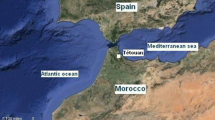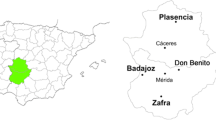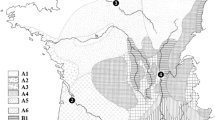Abstract
Very little is known in the UK about long term trends of theAlternaria spore although it is known to trigger asthma. It hasrecently become apparent that Alternaria spore levels areincreasing in Derby and a detailed study of Alternaria wasundertaken to investigate the increase in numbers, seasonal variationand diurnal periodicity. The seasonal (June—October)Alternaria spore concentrations show a distinct upward trendand there is evidence of an earlier seasonal start and an increase inthe seasonal duration. There has been a dramatic rise in the number ofdays with an Alternaria spore count above 50 spores per cubicmetre, with the peak daily count usually occurring in August butoccasionally in late July or early September. August generally has thehighest monthly total and for 1991–1998 there was a positivecorrelation with monthly rainfall and average temperature. Day to dayspore levels show a positive correlation between Alternariaspore concentrations and maximum temperature but a slight negativecorrelation with daily rainfall. The peak time for spore capture is14.00–22.00, and more than half the daily Alternariacatch is caught between 18.00 and 24.00 hours. The upward trend inAlternaria spore concentrations may be responsible forincreasing levels of respiratory disease, especially during harvesttime.
Similar content being viewed by others
References
Bass D. and Morgan G.: 1997, A three year (1993–1995) calendar of pollen and Alternaria mould in the atmosphere of south western Sydney. Grana 36, 293–300.
Buisseret P.D.: 1976, Seasonal allergic symptoms due to fungal spores. Br Med J, 507–508.
Corden J.M. and Millington W.M.: 1991, A study of Gramineae and Urticaceae Pollen in the Derby Area. Aerobiologia 7, 100–106.
Corden J. and Millington W.: 1999, A study of Quercus pollen in the Derby area. Aerobiologia 15, 29–37.
Corden J., Millington W., Bailey J., Brookes M., Caulton E., Emberlin J., Mullins J., Simpson C. and Wood A.: 2000, UK regional variations in Betula pollen (1993–1997). Aerobiologia 00, 1–6.
Driessen M.N.B.M., Herpen R.M.A. van and Smithius L.O.M.J.: 1990, Prediction of the start of the grass pollen season for the southern part of the Netherlands. Grana 29, 79–86.
Emberlin J., Mullins J., Corden J., Millington W., Brooke M., Savage M. and Jones S.: 1997, The trend to earlier Birch pollen seasons in the UK: A biotic response to changes in weather conditions? Grana 36, 29–33.
Emberlin J., Mullins J., Corden J., Jones S., Millington W., Brooke M. and Savage M.: 1999, Regional variations in grass pollen seasons in the UK, long-term trends and forecast models. Clin Exp Allergy 29, 347–356.
Fernández D., Valencia R.M., Molnar T., Vega A. and Sagues E.: 1998, Daily and seasonal variations of Alternaria and Cladosporium airborne spores in Leon (North-West, Spain). Aerobiologia 14, 215–220.
Frankland A.W. and Davies R.R.: 1965, Allergie aux spores de moisissures en Angleterre. Le Poumon et le Coeur 21, 11–23.
Gregory P.H. and Hirst J.M.: 1957, The summer Air-Spora at Rothamsted in 1952. J Gen Microbiol 17, 135–152.
Hirst J.M.: 1953, Changes in atmospheric spore content: Diurnal periodicity and the effects of weather. Trans Brit Mycol Soc 36, 375–392.
Hjelmroos M.: 1993, Relationship between airborne fungal spore presence and weather variables. Grana 32, 40–47.
Hopkins J.G., Benham R.W. and Kesten B.M.: 1930, Asthma due to a fungus-Alternaria. J Am Med Assoc 94, 6–10.
Hyde H.A. and Williams D.A.: 1946, A daily census of Alternaria spores caught from the atmosphere at Cardiff in 1942 and 1943. Trans Brit Mycol Soc 29, 78–85.
Last F.T.: 1955, The spore content of the air within and above mildew-infected cereal crops. Trans Brit Mycol Soc 38, 453–464.
Licorish K., Novey H.S., Kozak P., Fairshter R.D. and Wilson A. F.: 1985, Role of Alternaria and Penicillium spores in the pathogenisis of asthma. J Allergy and Clin Immunol 76, 819–825.
McCartney A. and Lacey M.: 1992, The production and release of plant pathogen spores in oilseed rape crops. In: Monitoring and Forecasting to Improve Crop and Environment Protection. Association of Applied Biologists, pp. 121–122.
Mitakakis T., Ong E.K., Stevens A., Guest D. and Knox R.B.: 1997, Incidence of Cladosporium, Alternaria and total fungal spores in the atmosphere of Melbourne (Australia) over three years. Aerobiologia 13, 83–90.
Mitakakis T.Z., Tovey E. and McGee P.: 1998, Exposure levels and sourcing of the airborne allergenic fungus Alternaria, in rural Australia. 6th International Congress on Aerobiology Perugia, Italy.
Morrow Brown H. and Jackson F.A.: 1978, Aerobiological studies based in Derby. I. A simplified volumetric spore trap. Clin Allergy 8, 589–597.
O'Hollaren M.T., Yunginger J.W., Offord K.P., Somers M.J., O'Connell E.J., Ballard D.J. and Sachs M.I.: 1991, Exposure to an aeroallergen as a possible precipitating factor in respiratory arrest in young patients with asthma. N Engl J Med 324, 359–363.
Peat J.K., Toelle B.G., Gray E.J., Haby M.M., Belousova E. Mellis C.M. and Woolcock A.J.: 1995, Prevalence and severity of childhood asthma and allergic sensitisation in seven climatic regions of New South Wales. Med Jour Aust 163, 22–26.
Sreeramulu T.: 1958, Effect of mowing grass on the concentrations of certain constituents of the air spora. Curr Sci 2, 61–63.
Stern M.A., Allitt U., Corden J. and Millington W.: 1999, The investigation of fungal spores in intramural air using a Burkard continuous recording air sampler. Indoor Built Environ 8, 40–48.
Targonski P.V., Persky V.W. and Ramekrishnan V.: 1995, Effects of environmental molds on risk of death from asthma during the pollen season. J Allergy Clin Immunol 95, 955–961.
Tariq S.M., Matthews S.M., Stevens M. and Hakim E.A.: 1996, Sensitization to Alternaria and Cladosporium by the age of 4 years. Clin Exp Allergy 26, 794–798.
Author information
Authors and Affiliations
Rights and permissions
About this article
Cite this article
Corden, J.M., Millington, W.M. The long-term trends and seasonal variation of the aeroallergen Alternaria in Derby, UK. Aerobiologia 17, 127–136 (2001). https://doi.org/10.1023/A:1010876917512
Issue Date:
DOI: https://doi.org/10.1023/A:1010876917512




